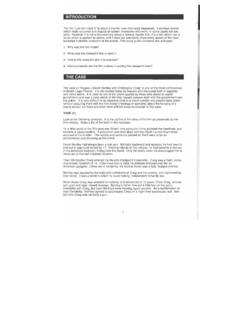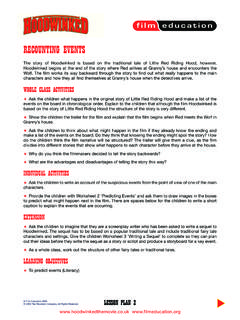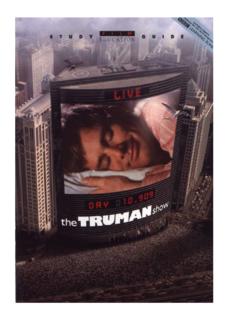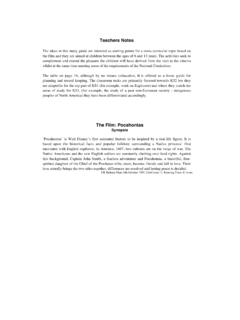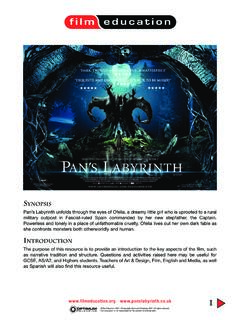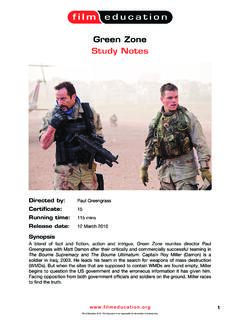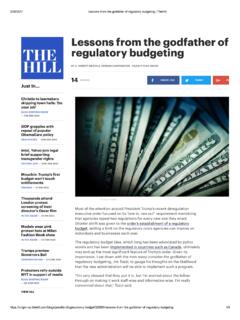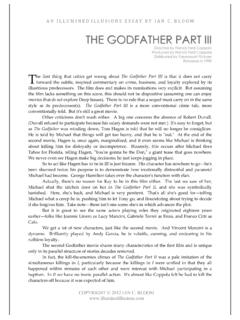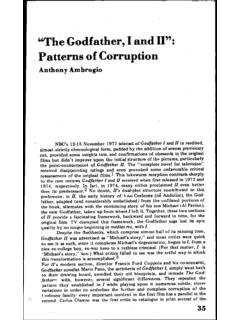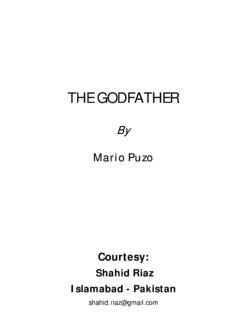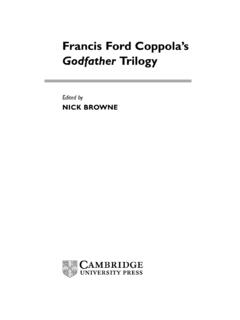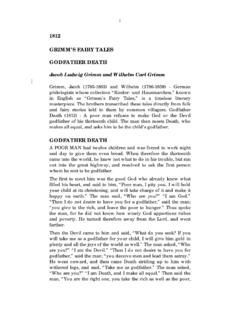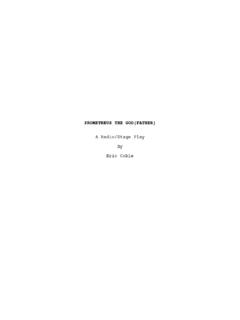Transcription of OSCAR WINNER 1972: Best Picture Best Actor This study ...
1 Film Education1 OSCAR WINNER 1972 : best PictureBest ActorBest Adapted ScreenplayTEACHERS NOTESThis study guide is aimed at students of GCSE Media Studies, A Level Film Studiesand GNVO Media: Communication and Production (Intermediate and Advanced).Specific areas of study covered by the guide are those of genre, representationand the issue of violence in godfather : Certificate 18. Running Time 175 CREDITS FOR THE GODFATHERThe godfather 1972 (Paramount)Producer:Albert S. RuddyDirector:Francis CoppolaScreenplay:Mario Puzo, Francis CoppolaDirector of Photography:Gordon WillisEditors:William Reynolds, Peter ZinnerMusic:Nino RotaArt Director:Dean TavoularisCast:Marion BrandoAl PacinoJames CaanRichard ConteRobert DuvallSterling HaydenOscars 1972 : best PictureBest Actor (Marion Brando) best Adapted ScreenplayOscar Nominations 1972 : best DirectorBest Supporting Actor (James Caan,Robert Duvall, Al Pacino) best Music [later declared incligiblelBest Costume DesignBest EditingBest Sound Film Education2 THE GODFATHERC oppola s The godfather was the direct descendant of dozens of gangster moviesmade with stars like Cagney and Edward C.]
2 Robinson. But there was a vitaldifference. Its examination of the Corleone family had a consistently humandimension that made the evil of the Mafia, who loved it for the wrong reasons, all themore horrendous. As a study of evil, it was all the better for assuming that suchdarkness emanated not from dyed-in-thewool villains but out of some of the familyvalues we now most cherish. Added to that, of course, was the brilliance of itsmaking, with Gordon Willis photography and Nino Rota s score adding to Coppola sfine orchestration of a terrific cast. If The godfather II was a more subtle explorationof the inevitable results of criminality on the personal lives of those who try to perfectit, this film in the trilogy was arguably more forcefully dramatic. Pacino, Brando andCaan have possibly never been better, nor has Coppola risen to the same heights inmatching pure entertainment with his dark vision of the American Dream turned Malcolm INTRODUCTIONE xtremely long, large and handsomely polished and artfully tailored gangster pieceabout, one presumes, the inner working of the Mafia, with Al Pacino as the quiet,pleasant young man turned by constant violence into the most bloodily ruthlessleader of all when he takes over from his old dad Marlon Brando.
3 Of suspect moraltone with its sentimentality about The Family: but coldly realistic in other bound for becoming one of the biggest cinematic moneymakers of all Review, October 1972 Paramount took an option on Mario Puzo s The godfather before it was published,when it was still only a twenty-page outline. The book, published in 1969, became abestseller (10 million copies) so any film version was fairly sure to be profitablebecause of the huge success of the novel. However, the studio were cautious aboutmaking the film as its previous Mafia movie, The Brotherhood starring Kirk Douglas,made in 1969, had been a flop. But given the success of the novel s paperbacksales a low budget screen version was considered a viable risk especially if it couldbe completed quickly and hit the screens while the book was still selling film was not intended to be a blockbuster. Paramount approached Coppola todirect. They knew they could sign him cheaply as his previous film had failed and hisfilm company, Zoetrope was in debt.
4 They also considered that his Italian name anddescent would be useful in the face of the opposition the studio expected from theItalian-American community and the Mafia. In fact, a promise was made to give theproceeds of the premiere to the Italian-American Civil Rights League who wereworried about defamation. There was an agreement that the crime syndicate would Film Education3not be referred to as the Mafia or Cosa Nostra but as five families , the termused by Puzo in the was young, 31, and idealistic. He had formed Zoetrope to give filmmakers anopportunity to work outside the Hollywood system. He told his father that Paramountwanted him to direct this hunk of trash. I don t want to do it. I want to do art films. Hethought some of the more squalid aspects of the book would spoil the film andconsidered the proposed budget too low. (The budget was fixed at $2 million andeventually cost $6 million.)
5 His father encouraged him to sign the contract and makemoney from the project so that he could make the kind of movies he wanted to. Heeventually agreed a fee of $125,000 and 6 per cent of the the editing stage of the film, Coppola said he was sure people would feel I hadtaken this exciting, bestseller novel and transformed it into a dark, ponderous, boringmovie with a lot of actors who were known to be my personal friends (excludingBrando). The film did of course become a blockbuster. By the end of 1972 it had earned morethan any other film in history grossing $150 million worldwide. It won Oscars for bestfilm, best Actor (MarIon Brando) and best screenplay from another medium (Coppolaand Puzo). As you work through this study guide you will build up your own ideas aboutwhy the film was such a Bare Bones of the film are included to help you to analyse this very long film andlocate the sequences you want to study in detail.
6 They do not indicate how the film tellsits story, represents its characters or conveys its themes. The numbering of items inthe Bare Bones section is for ease of reference and does not represent a definitivedivision of scenes. The guide will suggest ways you can use the Bare Bones to developyour understanding of the film. There are obviously ways you can use the Bare Boneswhich are not suggested in the GANGSTER GENREA udiences recognise a gangster film by its familiar icons: the concrete jungle setting;the brutal gangster hero with loyal or over-ambitious henchmen; women as sexualornaments, respectable mothers and sisters upholding traditional values; the overcoatswith turned-up collars, broad-brimmed hats, pistols, machine guns; montagesequences for violent action. Basic conflicts show gangster anarchy challenging thesocial order, leadership struggles, gang warfare against rival mobs, the internalstruggle of the hero as he chooses his comes through the hero getting his just desserts in the gutter or as a Film Education4reformed character; the social order is restored and values of decency and respect forlaw and order of the reasons that genre movies are made is because their quick productrecognition make them easier to sell.
7 Genres do not remain fixed because the cinemadoes not exist in isolation. Changes in social and economic conditions lead tochanges to the RESONANCESG angster movies have a powerful mythic resonance for audiences: one of theappeals of the gangster hero is as a Robin Hood figure protecting the weak andpoor against the rich and powerful. Gangster movies have often caused moraloutrage; The godfather is no exception. Since movie making began, authoritieshave feared that gangster movies romanticise violence and lawlessness. In thethirties, the film industry s governing body issued a number of rules which directorshad to hear in mind when they came to make gangster films to avoid turningcriminals into heroes and justifying their actions. This guide will ask you to thinkabout the values of The sees the Mafia as a metaphor for America and makes the metaphor thefocus of the film from the opening line, I believe in America.
8 He sees many linksbetween the Mafia and America: they both have roots in Europe; they both feel theyare benevolent organisations; both have their hands stained with blood from whatthey believe is necessary to do to protect their power and interests; both arecapitalist organisations motivated by OPENING SEQUENCEThe opening wedding sequence of the film lasts nearly 30 minutes out of the entire175 minute running time. It introduces the main characters and establishes thetensions of the film locating the movie firmly in the gangster film opens with Italian immigrant undertaker Bonasera asking Don Corleone theGodfather, to help him get justice against the young men who have assaulted andtried to rape his daughter; they have escaped with a suspended says, I believe in America. America s made my fortune. And I raised mydaughter in American fashion. I gave her freedom but I taught her never todishonour my family.
9 The courts have failed him so he is turning to Don Corleonebecause for justice, we must go to Don Corleone. Film Education5 Don Corleone reprimands him for not coming to him in the first place, for not evencalling him godfather : You find paradise in America. You had a good trade, made agood living, the police protected you and there were courts of law. You didn t need afriend like me. But now you come to me and you say, Don Corleone, give mejustice. But you don t ask with respect. You don t offer friendship. You don t eventhink to call me godfather . Instead you come into my house on the day mydaughter s getting married and you ask me to murder for money. The Don agrees to help Bonasera asking him to accept this justice as a gift on mydaughter s wedding day. He asks counsellor Tom Hagan to make sure the job isdone by reliable people for after all, We re not murderers.
10 TaskView the Bonasear sequence and consider the following questions: What tone is set by the Bonasera sequence? Consider the contribution offraming and type of shots, lighting, pace, acting, subject and themes of thedialogue. What do we learn about the aspirations of the Italian immigrant community? What do we learn about the Don from this sequence?TaskView the rest of the wedding sequence and discuss the following questions: How does the opening sequence confirm the film as a gangster movie? What gangster icons are used in the opening sequence? How does the opening sequence help us recognise the central characters? What expectations have been set up in your mind in terms of the development ofthe plot and character? Film Education6 HOW THE FILM TELLS ITS STORYA film is more than the sum total of its events. Filmmakers shape meaning throughthe visual elements of carnerawork, editing, choice of setting and set design, sound(including music), casting, acting and narrative structure.

